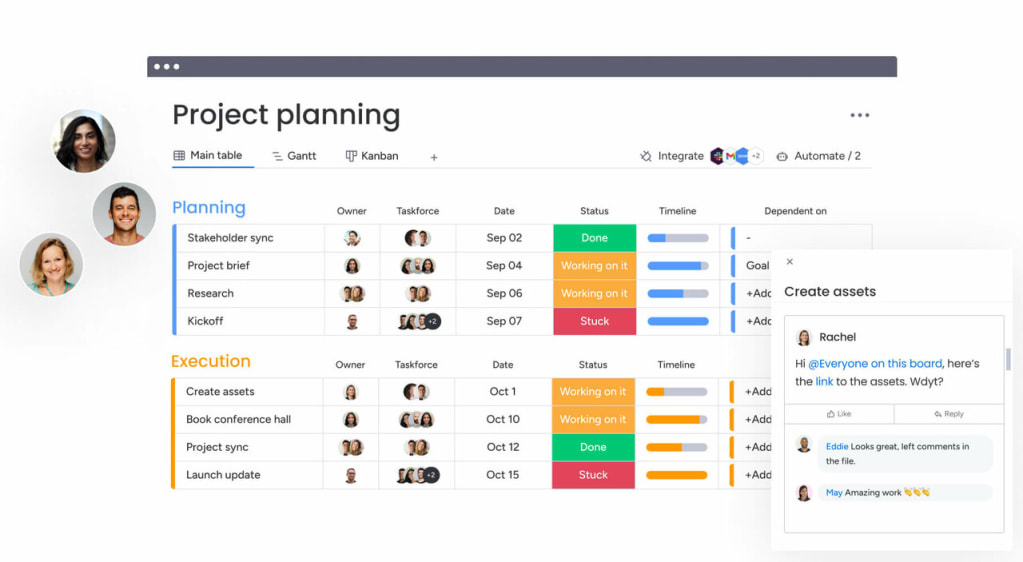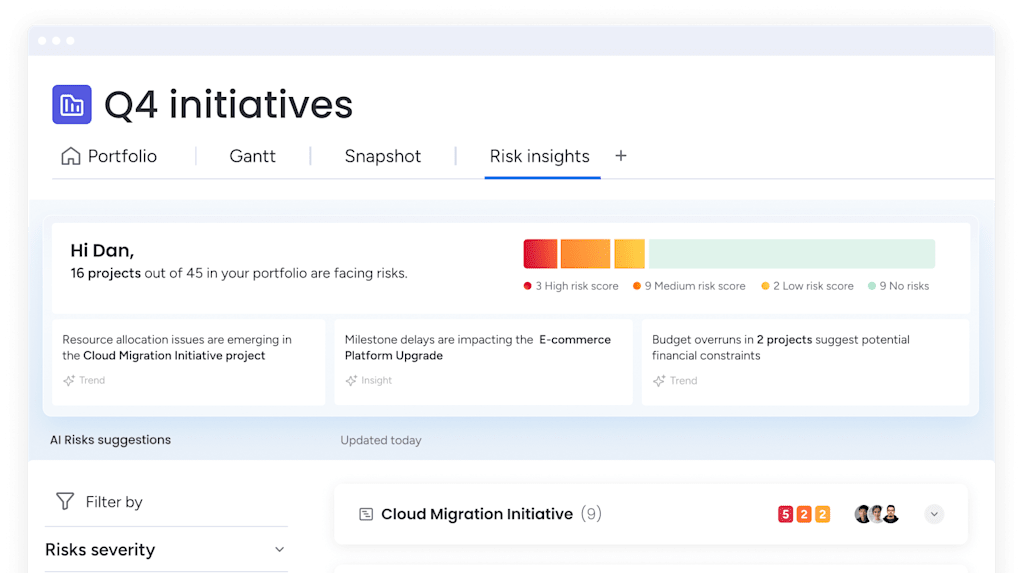In the project management space, keeping a comprehensive or birds-eye view of all ongoing projects is crucial for success. Project portfolio risk management is a concept that helps organizations identify, analyze, and respond to risks within a portfolio so that they can beat goals and create strategies moving forward.
To successfully implement portfolio risk management it’s important to use technological tools such as monday.com. In this piece we will look at portfolio risk management in project management, why it’s important, how to implement it, and how monday.com can help.
Get startedWhat is portfolio risk management?
Portfolio risk management is the process of overseeing and mitigating risks across the entire project range of a company (the portfolio). This process includes identifying, assessing, measuring, and managing risks within the portfolio. This is important because if a company is unable to recognize and deal with risks, it can impact the success of projects and ultimately — strategic goals and plans.
Project vs. portfolio risk management
The main difference between project and portfolio risk management is their scope and focus. Many organizations implement project risk management regularly. This includes looking at projects, seeing their opportunities and risks, and making changes accordingly. This can be done by a project manager or team lead and is relatively easy to implement.
Portfolio risk management requires a macro-level view and approach. This means that higher-level team members need to be involved due to the intricacies of strategic alignment and planning. Portfolio risk management looks at the bigger picture and understands how each project may affect others and the overall health of the project portfolio.

Read also: Portfolio management vs Project management
Why should you include portfolio risk management in your project strategy?
There are several benefits to incorporating enterprise risk management into your project management process including:
- Enhancing decision-making by having an overarching view of risks across all projects
- Prioritizing resources effectively making sure that resources aren’t wasted
- Aligning projects with the strategic objectives of the organization
- Increasing agility and flexibility by adapting to changes and unforeseen events
- Boosting stakeholder confidence by showing a proactive approach to handling uncertainties
By understanding the overall impact of risks across projects, project managers can make informed decisions to reduce negative impacts while capitalizing on opportunities that may arise from interconnected risks.
Get startedThe 4 steps to measure risk in your project portfolio
Risk management requires a method and strategy. Here are the 4 steps we recommend to start measuring risk in your portfolio.
1. Identify risks
To get started, you’ll need to understand the potential risks that could impact your portfolio. This includes going through each project in the portfolio, and looking at aspects such as complexity, technological challenges, market dynamics, and resource availability. Discuss with relevant stakeholders, steering committees, team members, and experts to get a deep analysis and understanding of the project. Use tools such as SWOT analysis in this phase.
Pro tip: want to have AI analyze all your risks? Check out our new features in our guide to AI-powered risk management.

2. Understanding and analyzing risks
Once you understand the risks in the projects and the portfolio overall, you’ll have to analyze them. This means understanding the likelihood of each risk occurring and what its impact is on the portfolio. You may use different methods here such as simulations or qualitative assessments.
3. Make an action plan
Now’s the time to deal with the risks. An action plan should include specific steps to reduce the likelihood of negative risks or how to respond if they do occur. This phase also includes identifying opportunities that certain risks might present. It’s important to keep this plan realistic and achievable. This phase also includes assigning responsibilities and resources for implementing risk management tactics.
4. Monitoring and controlling risks
Risk management is not a one-time activity. You’ll have to monitor and control risks over time including identifying them, reassessing impact and probability over time, and adjusting strategies as necessary. Implementing this step allows organizations to monitor and understand risk levels and adapt to new challenges and changes in the portfolio.
Using monday work management for portfolio risk management
monday work management is an ideal tool to help companies with portfolio risk management due to its flexibility and ability to provide high-level views.
After setting up boards related to various projects, managers can create dashboards and overarching boards that connect all projects and give a birds-eye view of the portfolio. This is critical for team leads who want to understand what projects are happening at any given time, what the status is, where bottlenecks are located, and more.

Customized dashboards also allow management to understand the profitability and overall health of project portfolios.
And of course, don’t forget our portfolio management template. This template allows organizations to plan, track, and manage projects (no matter how complex they are) with different views that are set up for you in advance.
Another important feature for understanding project risks is automations. Automations allow project managers to get alerted automatically regarding different project statuses, late deadlines, approvals, and more.

Leave unnecessary risks behind in your portfolio today
Portfolio risk management is essential for anyone who wants to keep up with today’s fast-paced business world. By gaining a holistic view of a project portfolio, managers are at an advantage to understanding their team’s advantages and disadvantages and can move forward without (or with minimal) surprises.
With over 72 integrations available and 27 different views, monday work management helps you gain knowledge of your portfolio risks easily and visually so that you can take action on time when needed.
FAQs
What does a project portfolio include?
A project portfolio includes all of the various projects a team or company is involved in. Managing portfolio risk helps organizations understand their strengths and weaknesses and to mitigate risk over time.
What are risks in project portfolios?
Different risks include schedule, costs, scope, and quality risks.
What are the 4 types of risk in project management?
There are four main types of risks within projects and portfolio management. These include technical, organizational, external, and project management.


